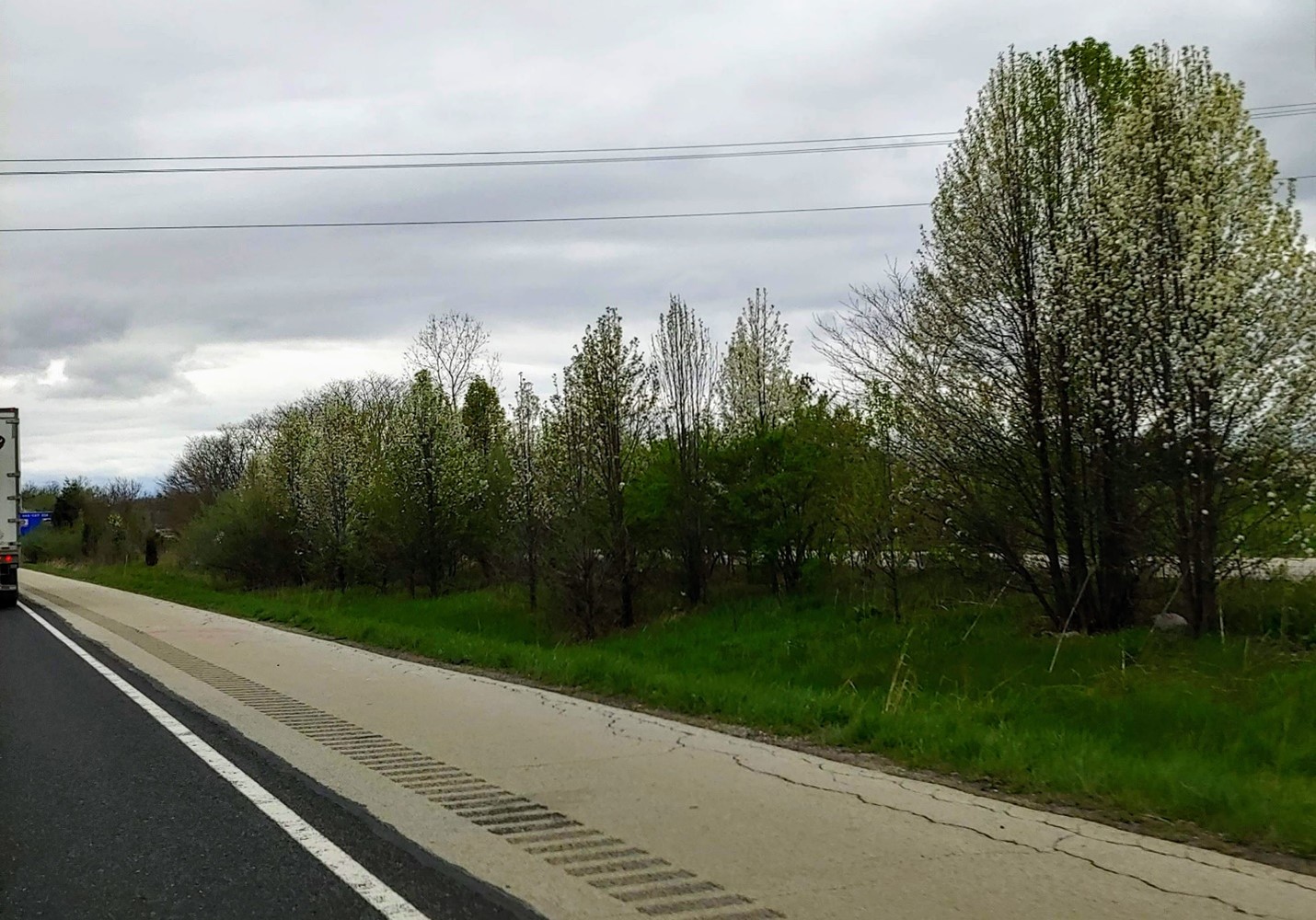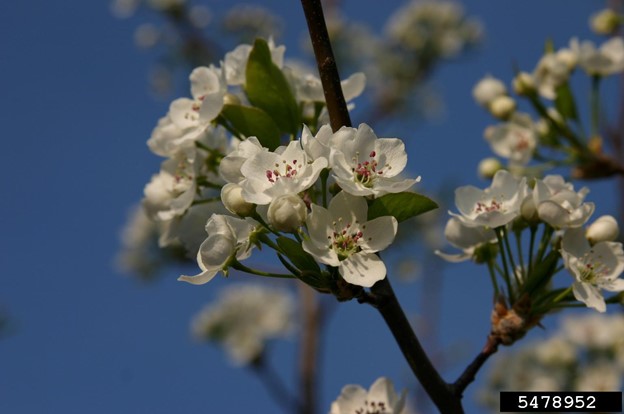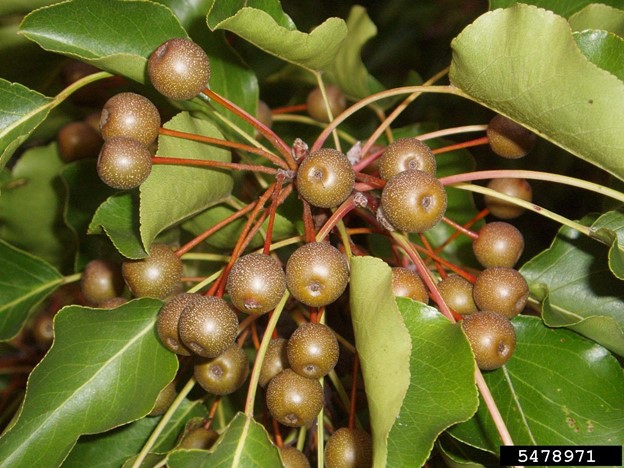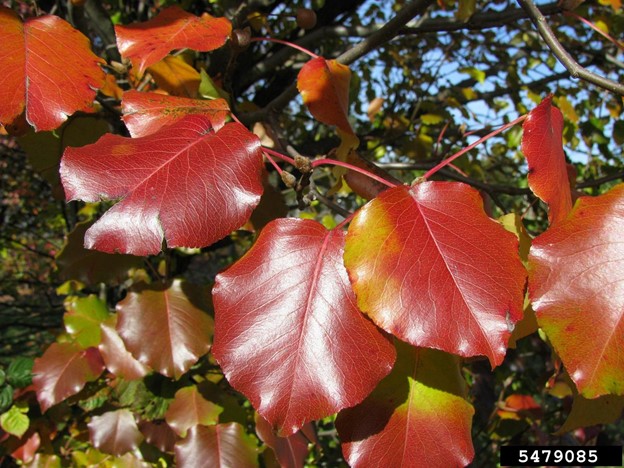Issue 2, May 12, 2022
Callery Pear Easily Noticeable in Bloom, and Threatening
You may have noticed white flowering trees nearly everywhere this spring. While they’re lovely, they can be too much of a good thing and possibly indicate an invasive problem. Callery Pear is in bloom now in Northern Illinois and was in full bloom very recently in Central Illinois. Blooms make these trees easily noticeable and bring awareness to the overabundant and worrisome population in many locations – typically where they don’t belong.

Multiple Callery Pear trees growing wild along an interstate near Chicago, Michelle Wiesbrook, University of Illinois.
Callery Pear (Pyrus calleryana) is also known as “Bradford” Pear which is its most widely planted cultivar. Other available cultivars include ‘Aristocrat’, ‘Cleveland Select’, and ‘Chanticleer’. It was once widely recommended as an ornamental and street tree due to its toughness, its glossy red leaves in the fall and its plentitude of early blooms in the spring. However, as time has passed the negative attributes of aggressive spreading and structural weakness have become apparent and more easily recognized. Some cities have now banned the planting of this popular tree that was once thought to be sterile. Most recently, Ohio has declared Callery Pear as invasive and banned it from being planted or sold starting in 2023. In Missouri, buy-back programs are being offered where a replacement, native tree is offered up in exchange for photos of you cutting your Callery Pear down.

Callery Pear flowers, Leslie J. Mehrhoff, University of Connecticut, Bugwood.org.
This native to Asia is a deciduous tree that grows 30 to 50 ft. tall. The leaves are alternate, simple and broad ovate to ovate with a small, round-toothed margin. Overall, the leaf margin has a distinct wave or ripple. Leaves are shiny, dark green and leathery, growing 1½ to 3 inches long. In the early spring before the leaves emerge, flowers appear as ball-shaped bundles. They are white with five petals and about 1 inch across. Flowers develop into ½ inch diameter hard, spotted, green to brown fruits. While the flowers are abundant and attractive, they have a strong, rancid smell akin to rotting cheese. Naturalized plants can have stout, sturdy spines. Callery Pear grows best in full sun but will tolerate some shade and is adapted to a wide range of environments. Spreading by seed, it forms dense thickets. It leafs-out early and hinders growth of understory plants leading to a loss of diversity.

Callery Pear fruit and leaves, Leslie J. Mehrhoff, University of Connecticut, Bugwood.org.
Introduced here early in the 1900’s, Callery Pear was used for experimentation in disease resistance of the common fruiting pear. During this breeding research, ‘Bradford’ Pear was discovered as a self-sterile cultivar. But shoots can arise from the rootstocks that cultivars are grafted onto and researchers now know that Bradford Pear and other cultivars can cross-pollinate resulting in small fruits containing an abundance of viable seeds which are eaten readily by birds and dispersed in their droppings. To make matters worse, wild individuals can then further the expansion and dispersal by interbreeding and producing even more viable seed. This tree is everywhere. It can be found in nearly every Illinois county. In addition to growing in landscapes, it is often found along roadsides, hedgerows, forest edges, natural areas, wetlands, and sites (old or open fields) that are not being mowed or maintained.
If you have missed the blooms in your area, this tree will be easy to spot again in the fall with its red to purple glossy leaves. Last fall was the first I had noticed all the young saplings that have filled the ditch all along a neighbor’s house. Numerous Callery pear cultivars can be found in their beautiful, rural landscape and with no close neighbors around their trees are the obvious source of the seed.

Callery Pear wild sapling turning red in fall, Leslie J. Mehrhoff, University of Connecticut, Bugwood.org.
If you have this tree in a landscape you own or manage, consider taking it down if you have the ability and means to easily do so. If not, don’t panic. But it would be wise to plan for a replacement in the future. Callery Pear has become notorious for having weak wood and narrow branch angles which make it particularly susceptible to ice storm damage. Many Callery Pears are lost and then replaced (hopefully with another type of tree) as a result of a bad storm.
Before adding this tree to your landscape, please consider the risks. Consider alternative flowering ornamentals when planting or replacing trees such as:
- Redbud (Cercis canadensis)
- Serviceberry (Amelanchier canadensis)
- American plum (Prunus americana)
- Flowering dogwood (Cornus florida)

Callery Pear fall color, Leslie J. Mehrhoff, University of Connecticut, Bugwood.org.
When it comes to controlling Callery Pear, one sharp cut at the base can go a long way, however, it likely won’t completely kill this tough tree. Resprouting will typically occur unless a herbicide is applied to the base. This tree could also be controlled without cutting it, however remaining dead vegetation will probably need to be removed. Herbicide recommendations include the following.
- Foliar: Apply 2 to 4% v/v glyphosate in water or 1 to 2% v/v triclopyr in water.
- Basal bark: Plants 4 inches in diameter or less – apply a triclopyr ester formulation at a 20% v/v rate, mixed with basal oil, to the lowest 15 inches of the stem.
- Cut stump: Apply glyphosate at a 25 to 50% v/v rate in water or triclopyr amine in water or ester in oil at a 20 to 25% v/v rate within 10 minutes of cutting. Always read and follow the herbicide label before initiating treatment.
Of course seedlings and shallow-rooted plants can be hand-pulled or dug up. Wait until after a rain to make the task easier.
Additional Resources:
go.illinois.edu/BradfordPearSV
go.illinois.edu/CalleryPearCaution
Management of Invasive Plants and Pests of Illinois
Author:
Michelle Wiesbrook